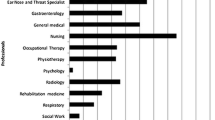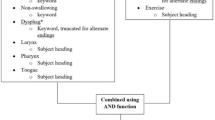Abstract
This article reports on the use of a new tool from the Australian Therapy Outcome Measures (AusTOMs) set—the Swallowing scale. The scale is one of six, designed to measure outcomes of clients attending speech pathology practices in Australia. The tool was used for six months in clinical practices across 14 healthcare sites in Victoria, Australia (including six acute hospitals, six rehabilitation services, one specialist pediatric hospital, and one specialist cancer institute). This article provides preliminary descriptive data and analyses of outcomes from swallowing therapy, along with discussion of the strengths and weaknesses of this tool. Potential clinical applications are suggested.






Similar content being viewed by others
References
InstitutionalAuthorNameWorld Health Organization (2001) International Classification of Functioning, Disability and Health (ICF) WHO Geneva, Switzerland
JA Logemann (1998) Evaluation and Treatment of Swallowing Disorders EditionNumber2 ProEd Austin, TX
Speech Pathology Department, Royal Brisbane Hospital, Royal Brisbane Hospital Outcome Measure for Swallowing, 1998
EC Ward A Conroy (1999) ArticleTitleValidity, reliability and responsiveness of the Royal Brisbane Hospital Outcome Measure for Swallowing Asia Pacific J Speech Lang Hear 4 109–129
CA McHorney DE Bricker AE Kramer JC Rosenbek J Robbins KA Chignell JA Logemann C Clarke (2000) ArticleTitleThe SWAL-QOL outcomes tool for oropharyngeal dysphagia in adults: I. Conceptual foundation and item development Dysphagia 15 115–121 Occurrence Handle1:STN:280:DC%2BD3czpsVKmsg%3D%3D Occurrence Handle10839823
PM Ellwood (1988) ArticleTitleThe Shattuck lecture—Outcomes management: A technology of patient experience New Engl J Med 318 1549–1556 Occurrence Handle1:STN:280:DyaL1c3hs1Oluw%3D%3D Occurrence Handle3367968 Occurrence Handle10.1056/NEJM198806093182329
S Ohman J Barr G Schumacher (1995) ArticleTitleHealth status measures in allied health curricula: Results of a national survey J Allied Health 24 57–63 Occurrence Handle1:STN:280:DyaK2Mzos1Cmsg%3D%3D Occurrence Handle7657586
C Unsworth (2000) ArticleTitleMeasuring the outcome of occupational therapy: Tools and resources Aust Occup Ther J 41 147–158 Occurrence Handle10.1046/j.1440-1630.2000.00239.x
A Hesketh B Hopcutt (1997) ArticleTitleOutcome measures for aphasia therapy: it’s not what you do, it’s the way that you measure it Eur J Disord Commun 32 203–216 Occurrence Handle10.3109/13682829709177096
A John P Enderby (2000) ArticleTitleReliability of speech and language therapists using Therapy Outcome Measures Int J Lang Commun Disord 35 287–302 Occurrence Handle10.1080/136828200247197 Occurrence Handle1:STN:280:DC%2BD3czptlCisw%3D%3D Occurrence Handle10912256
C Butler (1995) ArticleTitleOutcomes that matter Dev Med Child Neurol 37 753–754 Occurrence Handle1:STN:280:DyaK28%2FhslGgug%3D%3D Occurrence Handle7589857 Occurrence Handle10.1111/j.1469-8749.1995.tb12058.x
JT Barr (1994) ArticleTitlePatient-centred outcome measures of accrediation J Allied Health Winter 47–49
P Enderby (1992) ArticleTitleOutcome measures in speech therapy: Impairment, disability, handicap, distress Health Trends 24 61–64 Occurrence Handle1:STN:280:DyaK3s%2FkvFWmsQ%3D%3D Occurrence Handle10171254
G Andrews (1995) ArticleTitleBest practices for implementing outcomes management. More science, more art, worldwide Behav Healthc Tomorrow 4 19–21 Occurrence Handle1:STN:280:DyaK2MzjtVCksQ%3D%3D Occurrence Handle10143413
S Reilly J Oates J Douglas (Eds) (2004) Evidence based practice in speech pathology Whurrr London
Worrall L, Outcome measures for speech pathology. In: Speech Pathology Circular, Commonwealth Department of Veterans Affairs 2, 2001
P Enderby A John (1997) Therapy Outcome Measures Speech-Language Pathology Technical Manual Singular Publishing Group San Diego, CA
Skeat JA: Implementing outcomes: barriers and facilitators to change (preliminary findings). Presentation made at the Speech Pathology Australia conference, Hobart, Tasmania, Australia, 2003
CA McHorney J Robbins K Lomax JC Rosenbek K Chignell AE Kramer DE Bricker (2002) ArticleTitleThe SWAL-QOL and SWAL-CARE outcomes tool for oropharyngeal dysphagia in adults: III Documentation of reliability and validity Dysphagia 17 IssueID2 97–114 Occurrence Handle10.1007/s00455-001-0109-1 Occurrence Handle11956835
P Enderby A John (1999) ArticleTitleTherapy outcome measures in speech and language therapy: Comparing performance between different providers Int J Lang Commun Disord 34 417–429 Occurrence Handle10.1080/136828299247360 Occurrence Handle1:STN:280:DC%2BD3czktlehsQ%3D%3D Occurrence Handle10884909
InstitutionalAuthorNameWorld Health Organization (1980) International Classification of Impairments, Disabilities and Handicaps (ICIDH) WHO Geneva, Switzerland
World Health Organization: Resolution of the executive board of the WHO, International Classification of Functioning, Disability and Health, 2001
P Enderby A John B Petherham (1998) Therapy Outcome Measures Manual: Physiotherapy, Occupational Therapy, Rehabilitation Nursing Singular San Diego, CA
P Enderby A John A Hughes B Petherham (2000) ArticleTitleBenchmarking in rehabilitation: Comparing physiotherapy services Br J Clin Governance 5 86–92 Occurrence Handle10.1108/14664100010343890
A Perry M Morris C Unsworth SJ Duckett JA Skeat K Dodd N Taylor K Reilly (2004) ArticleTitleTherapy outcome measures for allied health practitioners in Australia: The AusTOMs Int J Qual Health Care 16 285–291 Occurrence Handle10.1093/intqhc/mzh059 Occurrence Handle15252002
Acknowledgement
Funding for the Australian Therapy Outcome Measures (AusTOMs) project was provided by the Australian Commonwealth Department of Health and Ageing.
Author information
Authors and Affiliations
Corresponding author
Additional information
An erratum to this article is available at http://dx.doi.org/10.1007/s00455-005-0046-5.
Appendix 1: Final AusTOMs Swallowing Scale
Appendix 1: Final AusTOMs Swallowing Scale
The “Swallowing” scale incorporates all disorders of the structure and/or function of the swallowing mechanism, and/or feeding in both adults and children. Issues of safety and alternative feeding may be rated under the “Activity Imitation” domain.
Impairment of either Structure or Function (as appropriate to age):
Impairments are problems in body structure (anatomical) or junction (physiological) as a significant deviation or loss.
0 Profound swallowing/feeding impairment: No swallow/suck initiated. Difficulty in opening mouth. No functional movement of oral and/or pharyngeal structures or musculature.
1 Severe swallowing/feeding impairment: Swallow/suck initiated but is inconsistent/very delayed/severely disordered. Severe oral and/or pharyngeal impairment with no control of bolus.
2 Moderate/severe swallowing/feeding impairment: Swallow/suck initiated but may be inconsistent/delayed/disordered. Moderate oral and/or pharyngeal impairment with poor control of bolus (eg pharyngeal leakage/spillage).
3 Moderate swallowing/feeding impairment: Swallow/suck initiated consistently but delayed/abnormal. Moderate oral and/or pharyngeal impairment with limited bolus control (e.g., pooling, residue postswallow, buccal pocketing).
4 Mild swallowing/feeding impairment: Swallow/suck initiated consistently with appropriate timing and coordination. Mild oral and/or pharyngeal impairment with mild difficulties in bolus control (e.g., mild pooling or delay).
5 No swallowing/feeding impairment: Swallow/suck initiated consistently with appropriate timing and coordination and full control of bolus.
Activity Limitation (as appropriate to age):
Activity limitation results from the difficulty in the performance of an activity. Activity is the execution of a task by an individual.
0 Unable to manage own secretions (if tracheostomy is in situ, it is cuffed). Unable to safely manage any oral intake. Requires full alternative (e.g., PEG, NGT) nutrition.
1 Can sometimes manage own secretions with prompts (if cuffed tracheostomy is in situ, may be deflated). May sometimes safely take small practice amounts of modified consistencies. Requires mainly alternative (e.g., PEG, NGT) or supplementary nutrition.
2 Can manage own secretions safely and independently (if tracheostomy is in situ, it may be uncuffed). Safe on a limited range of consistencies, requires strategies and full supervision to manage oral intake. Some alternative/supplementary feeding (e.g., NGT) required.
3 Can manage a diet of modified consistencies. Some supervision/strategies may be required. No alternative or supplementary feeding required.
4 Can manage most consistencies, may require some restrictions in range of consistencies. Independent using strategies, with no supervision required. May eat/drink slowly.
5 Can manage a full diet in a timely manner and independently.
Participation Restriction (as appropriate to age):
Participation restrictions are difficulties the individual may have in the manner or extent of involvement in their life situation. Clinicians should ask themselves: “Given their problem, is the individual experiencing disadvantage?”
0 Unable to fulfill social, work, educational, or family roles. No social integration. No involvement in decision-making. No control over environment. Unable to reach potential in any situation.
1 Severe difficulties in fulfilling social, work, educational, or family roles. Very limited social integration. Very limited involvement in decision-making. Very little control over environment. Can only rarely reach potential with maximum assistance.
2 Moderately severe difficulties in fulfilling social, work, educational, or family roles. Limited social integration. Limited involvement in decision-making. Control over environment in one setting only. Usually reaches potential with maximum assistance.
3 Moderate difficulties in fulfilling social, work, educational, or family roles. Relies on moderate assistance for social integration. Limited involvement in decision-making. Control over environment in more than one setting. Always reaches potential with maximum assistance and sometimes reaches potential without assistance.
4 Mild difficulties in fulfilling social, work, education, or family roles. Needs little assistance for social integration and decision-making. Control over environment in more than one setting. Reaches potential with little assistance.
5 No difficulties in fulfilling social, work, educational, or family roles. No assistance required for social integration or decision-making. Control over environment in all settings. Reaches potential with no assistance.
Distress/Wellbeing (as appropriate to age):
The level of concern experienced by the individual. Concern may be evidenced by anger, frustration, apathy, depression, etc.
0 High and consistent levels of distress or concern.
1 Severe concern, becomes distressed or concerned easily. Requires constant reassurance. Loses emotional control easily.
2 Moderately severe concern. Frequent emotional encouragement and reassurance required.
3 Moderate concern. May be able to manage emotions at times, although may require some encouragement.
4 Mild concern. Able to manage emotions in most situations. Occasional emotional support or encouragement needed.
5 Able to cope with most situations. Accepts and understands own limitations.
Rights and permissions
About this article
Cite this article
Skeat, J., Perry, A. Outcome Measurement in Dysphagia: Not So Hard to Swallow. Dysphagia 20, 113–122 (2005). https://doi.org/10.1007/s00455-004-0028-z
Issue Date:
DOI: https://doi.org/10.1007/s00455-004-0028-z




